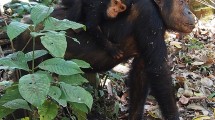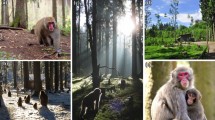Abstract
For more than 21 years a small semi-isolated group of wild chimpanzees have been studied at Bossou, Guinea, west Africa. All individuals have been identified since the beginning of the study. Remaining rates of infants (0–3 yr) and juveniles (4–7 yr) in the group were 64–80% for both sexes, however, those of adolescents (8–11 yr) dropped drastically, particularly for males (14%). As a result, most natal males as well as females disappeared before fully maturing. Two male visitors and an immigrant were observed in the group. More adult males than females disappeared from Bossou. Group males could be excluded as the genetic father of an offspring born in the group. From these demographic trends it is highly likely that some of these males emigrated rather than succumbed to sickness and death. It seems likely that they left on their own by choice. The reason for male dispersal is hypothesized to be influenced by intra-group male-male competition and the habitat ecology and structure of Bossou. There are no competitive adjacent groups or predators to prevent males from living alone and males can sire offspring out of their natal group.
Similar content being viewed by others
References
Baker, R. R. 1978.Evolutionary Ecology of Animal Migration. Hadder & Stoughton, London.
Boesch, C. 1996. The emergence of cultures among wild chimpanzees.Proc. Brit. Academy, 88: 251–268.
Gagneux, P.;Woodruff, D. S.;Boesch, C. 1997. Furtive mating in female chimpanzees.Nature, 387: 358–359.
Gauthreaux, S. A. Jr. 1978. The ecological significance of behavioural dominance. In:Perspectives in Ethology, Vol. 3,Bateson,P. P. G.;Klopfer P. H. (eds.), Plenum Press, London, pp. 17–54.
Goodall, J. 1983. Population dynamics during a 15 year period in one community of free-living chimpanzees in the Gombe National Park, Tanzania,Z. Tierpsychol., 61: 1–60.
Goodall, J. 1986.The Chimpanzees of Gombe: Patterns of Behavior, Belknap Press, Harvard Univ. Press, Cambridge, Massachusetts.
Greenwood, P. J. 1980. Mating systems, philopatry, and dispersal in birds and mammals.Anim. Behav., 28: 1140–1162.
Hiraiwa-Hasegawa, M.;Hasegawa, T.;Nishida, T. 1984. Demographic study of a large-sized unit-group of chimpanzees in the Mahale Mountains, Tanzania: a preliminary report.Primates, 25: 401–413.
Nishida, T.;Hiraiwa-Hasegawa, M. 1985. Responses to a stranger mother-son pair in the wild chimpanzee: a case report. Primates, 26: 1–13.
Nishida, T.;Hiraiwa-Hasegawa, M.;Hasegawa, T. 1985. Group extinction and female transfer in wild chimpanzees in the Mahele National Park, Tanzania.Z. Tierpsychol., 67: 284–301.
Nishida, T.;Takasaki, H.;Takahata, Y. 1990. Demography and reproductive profiles. In:The Chimpanzees of the Mahale Mountains,Nishida,T. (ed.), Univ. of Tokyo Press, Tokyo, pp. 63–97.
Normile, D. 1998. Habitat seen playing larger role in shaping behavior.Science, 276: 1454–1455.
Robbins, M. M. 1995. A demographic analysis of male life history and social structure of mountain gorillas.Behaviour, 132: 21–47.
Sugiyama, Y. 1994. Age-specific birth rate and lifetime reproductive success of chimpanzees at Bousou, Guinea,Amer. J. Primatol., 32: 311–318.
Sugiyama, Y.;Kawamoto, S.;Takenaka, O.;Kumazaki, K.;Miwa, N. 1993. Paternity discrimination and inter-group relationships of chimpanzees at Bossou,Primates 34: 545–552.
Sugiyama, Y.;Koman, J. 1979. Social structure and dynamics of wild chimpanzees at Bossou, Guinea.Primates, 20: 323–339.
Takahata, H.;Takahata, Y. 1989. Inter-unit group transfer of an immature male common chimpanzee and its social interactions in non-natal group.Afr. Study Monogr., 9: 209–220.
Uehara, S.;Hiraiwa-Hasegawa, M.;Hosaka, K.;Hamai, M. 1994. The fate of defeated alpha male chimpanzees in relation to their social networks.Primates, 35: 49–55.
Wrangham, R. W. 1980. An ecological model of female-bonded primate groups.Behaviour, 75: 262–299.
Yamagiwa, J. 1987. Male life history and the social structure of wild mountain gorillas (Gorilla gorilla beringei). In:Evolution and Coadaptation in Biotic Communities,Kawano,S.;Connell,J. H.;Hidaka,T. (eds.), Univ. of Tokyo Press, Tokyo, pp. 31–51.
Author information
Authors and Affiliations
About this article
Cite this article
Sugiyama, Y. Socioecological factors of male chimpanzee migration at Bossou, Guinea. Primates 40, 61–68 (1999). https://doi.org/10.1007/BF02557702
Received:
Accepted:
Issue Date:
DOI: https://doi.org/10.1007/BF02557702




